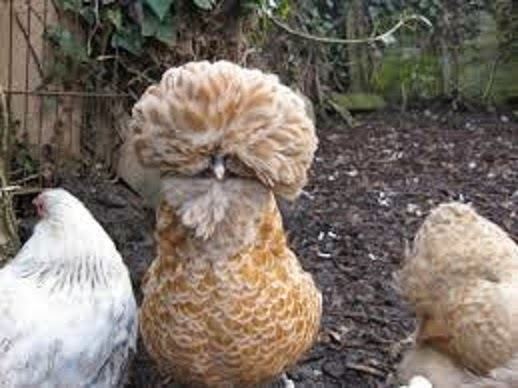Conservation status Recovering Skin color White Primary use ornamental Temperament Confident | Country of origin Padova, Italy Comb type None Egg size Small Egg color Light brown, Cream | |
 | ||
Other names Padovana dal gran ciuffo Weight Male: 1.8–2.3 kgFemale: 1.5–2.0 kg Recognized variety Black laced golden, Cuckoo, Lavender Similar Polish chicken, Sebright chicken, Brahma chicken, Wyandotte chicken, Cochin chicken | ||
The Padovana or Padovana dal gran ciuffo is an ancient breed of small crested and bearded chicken from the city and surrounding province of Padova, in the Veneto region of north-eastern Italy, from which it takes its name. Despite continuing discussion surrounding its true origins, it is recognised in Italy as an indigenous Italian breed.
Contents

History

The early history of the Padovana is unclear, and the subject of continuing discussion, as is its relationship to the Polish and the Dutch crested (Hollandse Kuifhoen) and Dutch bearded crested (Nederlandse Baardkuifhoen) breeds, which are variously considered to have originated in the Netherlands, in Poland, in Russia, or elsewhere. It is often reported that the Padovana was brought from Poland to Italy by the "Marquis" Giovanni Dondi dell'Orologio (1330–88). However the Dondi who was ennobled was the soldier Francesco Dondi, created Marquis by King John III Sobieski in 1676; no journey to or contact with Poland by Giovanni Dondi in the 14th century is documented.

Two sources provide evidence of crested chickens in Europe in Roman times: the two marble statuettes of crested chickens noticed in the Sala degli Animali ("animal hall") of the Vatican Museums in 1927 by Alessandro Ghigi date from the 1st or 2nd century AD; a chicken skull excavated at West Hill, Uley, Gloucestershire in England shows the typical cerebral hernia of the crested breeds and dates from the 4th century.
Early iconographic evidence of the breed in Padova is the fresco of the Annunciation by Jacopo da Verona, painted in 1397 in the Oratorio di San Michele Arcangelo (oratory of Saint Michael) in Padova, which shows a peasant woman feeding a crested hen and her chicks.
The Padovana is described and illustrated as gallina patavina, or Paduan hen, by Ulisse Aldrovandi in the second part of his work on ornithology, Ornithologiae tomus alter cum indice copiosissimo variarum linguarum (Bologna, 1600).
In the 21st century, breed numbers remain low. A study published in 2007 used a figure of approximately 1200 for the total breeding stock, of which approximately 300 were cocks.
Characteristics
Nine colour varieties are recognised for the Padovana, of which six are well-known and documented in older treatises: white, black, silver laced, gold laced, buff laced and "sparrowhawk". The skin is white and the legs slate-coloured or black. The comb is absent and the wattles vestigial, the ear-lobes are small, whitish and completely covered by the crest. Average weight is 1.8–2.3 kg (4.0–5.1 lb) for cocks, 1.5–2.0 kg (3.3–4.4 lb) for hens. The eggs vary from cream to light brown, and weigh approximately 35 g or 50 g.
